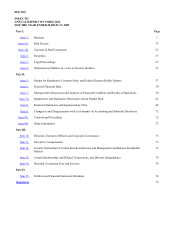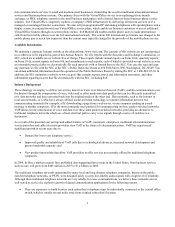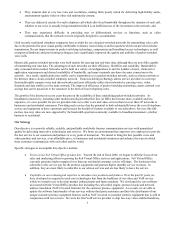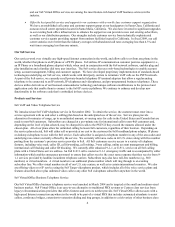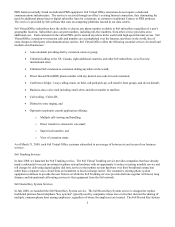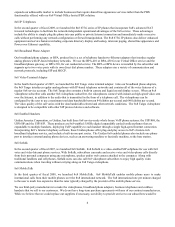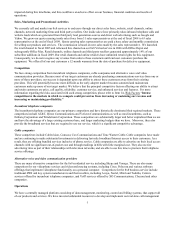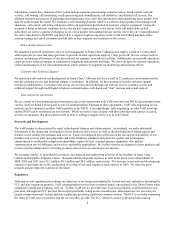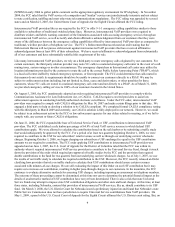8x8 2009 Annual Report Download - page 12
Download and view the complete annual report
Please find page 12 of the 2009 8x8 annual report below. You can navigate through the pages in the report by either clicking on the pages listed below, or by using the keyword search tool below to find specific information within the annual report.10
May 14, 2009, the Nebraska Public Service Commission requested a rehearing or a rehearing en banc of the decision handed
down by the three-judge panel. We cannot predict the outcome of this ongoing litigation. As of March 31, 2009, we were
collecting and remitting state USF in one state. Effective June 1, 2009, we will cease collecting and remitting state USF.
On April 2, 2007, the FCC released an order extending the application of customer proprietary network information, or CPNI,
rules to interconnected VoIP providers. CPNI includes information such as the phone numbers called by a consumer the
frequency, duration, and timing of such calls and any services/features purchased by the consumer, such as call waiting, call
forwarding, and caller ID, in addition to other information that may appear on a consumer’ s bill. Under the FCC’ s existing
rules, carriers may not use CPNI without customer approval except in narrow circumstances related to their provision of
existing services, and must comply with detailed customer approval processes when using CPNI outside of these narrow
circumstances. The new CPNI requirements are aimed at establishing more stringent security measures for access to a
customer’ s CPNI data in the form of required passwords for on-line access and call-in access to account information as well as
customer notification of account or password changes. Currently, we do not utilize our customer’ s CPNI in a manner which
would require us to obtain consent from our customers, but in the event that we do in the future, we will be required to adhere
to specific CPNI rules aimed at how such information is utilized. Effective December 8, 2007, we implemented internal
processes in order to be compliant with all of the FCC’ s other CPNI rules and we filed our second, annual certification of our
compliance with CPNI rules with the FCC on February 20, 2009. These rules may impose additional compliance costs on our
business and reduce our profitability or cause us to increase the retail price for our services.
On June 1, 2007, the FCC released a Notice of Proposed Rulemaking Proceeding to consider whether it should impose
additional VoIP E-911 obligations on interconnected VoIP providers including consideration of a requirement that
interconnected VoIP providers automatically determine the physical location of their customer rather than allow customers to
manually register their location. The Notice includes a tentative conclusion that all interconnected VoIP service providers that
allow customers to use their service in more than one location (nomadic VoIP service providers such as us) must utilize
automatic location technology that meets the same accuracy standards applicable to providers of commercial mobile radio
services (mobile phone service providers). We cannot predict the outcome of this proceeding nor its impact on our business at
this time.
On June 8, 2007, the FCC released an order implementing various recommendations from its Independent Panel Reviewing the
Impact of Hurricane Katrina on Communications Networks Panel, including a requirement that certain interconnected VoIP
providers submit reports regarding the reliability and resiliency of their 9-1-1 systems. At this time, we are not subject to these
reporting requirements but may become subject in future years.
On June 15, 2007, the FCC extended the disability access requirements of Sections 225 and 255 of the Communications Act,
which applied to traditional phone services, to providers of interconnected VoIP services and to manufacturers of specially
designed equipment used to provide those services. Section 255 of the Communications Act requires service providers to
ensure that its equipment and service is accessible to and usable by individuals with disabilities, if readily achievable, including
requiring service providers to ensure that information and documentation provided in connection with equipment or services be
accessible to people with disabilities, where readily achievable and that employee training account for accessibility
requirements. In addition, the FCC said that interconnected VoIP providers were subject to the requirements of Section 225,
including contributing to the Telecommunications Relay Services, or TRS, fund and that they must offer 7-1-1 abbreviated
dialing for access to relay services. At this time, we cannot predict the impact of these rules on our business or our ability to
comply with these disability access obligations. We may be subject to enforcement actions including, but not limited to, fines,
cease and desist orders, or other penalties if we are not able to comply with these new disability obligations. The rules
established in the Disability Access Order were scheduled to become effective on October 5, 2007, and as of this date, we
began to remit TRS fund contributions and have implemented 7-1-1 abbreviated dialing which connects all of our customers to
California relay service operators. The FCC granted a limited waiver of the 7-1-1 call handling requirement. While still
mandating that interconnected VoIP providers like us are required to transmit 7-1-1 calls to a relay center and to contribute to
the TRS fund, the FCC waived the requirement, until March 31, 2009, insofar as it requires such providers to transmit the 7-1-1
call to an “appropriate relay center,” meaning the relay center(s) serving the state in which the caller is geographically located
or the relay center(s) corresponding to the caller’ s last registered address. As of April 5, 2008, we have implemented a 7-1-1
system which routes such calls to the appropriate relay center based upon the telephone number assigned to the telephone
placing the 7-1-1 call.
On August 6, 2007, the FCC released a Report and Order concerning the collection of regulatory fees for Fiscal Year 2007
("Regulatory Fees Order"), which, for the first time, mandates the collection of such fees from interconnected VoIP service
providers like us. The Regulatory Fees Order requires that interconnected VoIP providers pay regulatory fees based on reported
interstate and international revenues. The Regulatory Fees Order became effective in November 2007. The assessment of


